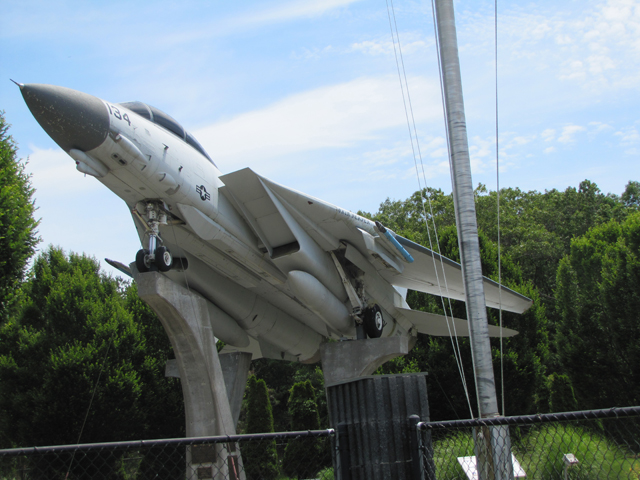As one Grumman memorial is planned, is another leaving?

Plans for a new monument in memory of two Grumman test pilots who died in a 1967 crash took a step forward last Thursday, as Riverhead Town Board members gave an informal OK to bringing in a three-ton boulder to which a plaque would be affixed.
Supervisor Sean Walter also raised the possibility that the existing F-14 Tomcat display at Grumman may be leaving.
Aldo Catsaros and Fred Miller appeared at last week’s Town Board’s work session to provide an update. The new monument would honor pilots Charles “Buck” Wangeman and Ralph “Dixie” Donnell, who were killed April 21, 1967, while testing a General Dynamics/Grumman F-111B fighter jet at the Calverton facility.
A mislabeled switch led to the engine being choked off and when the pilots pulled the ejection handle, it broke off, according to the Naval Aviation Safety Center’s investigation of the crash.
Mr. Catsaros has worked for three years on creating a memorial to the pilots. Last week, he said, “there it was. The perfect boulder” for the monument, which he found at a Calverton sand mine.
The boulder weighs about 6,000 pounds and measures about seven feet by four feet by 30 inches high.
“It’s absolutely perfect for the plaque,” Mr. Catsaros said in an interview.
The memorial is proposed for the front of the guard shack, next to the F-14 Tomcat, he said.
At the work session, he asked for the town’s help in moving the boulder to the site.
“We’d love to support you,” Mr. Walter said. “Let’s get that boulder moved.”
The Grumman Memorial Park is about 10 acres, but to date, only about two acres have been developed due to lack of funding, officials said.
At last week’s work session, when Mr. Catsaros began discussing the possibility of moving other retired military aircraft to the site, Mr. Walter cautioned “that’s a sticky wicket.”
“These planes can only stay on a static display for a certain period of time,” he said.
The F-14 fighter plane that’s been on a pedestal at the memorial park for 17 years “probably needs to come down and go away,” the supervisor said, adding that wear and tear on the planes from the weather will eventually make the display unsafe.
He said he learned this from a representative of the Cradle of Aviation Museum in Garden City, whose name he couldn’t recall. But Andy Parton, executive director of that museum, said in an interview Friday that his staff or volunteers would not have said that.
“The issue in the past was that the town couldn’t afford to maintain them, so the museum had sent out volunteers to help with the painting and scraping and we’ve been doing that on an ongoing basis,” Mr. Parton said.
Most of the military planes on display throughout the country are on loan from the military, he said.
“The last thing they want to do is take an aircraft back, because it’s an expensive process,” he said.
Mr, Parton said the museum will continue to help maintain the planes at the Grumman Memorial, which has an F-14 Tomcat on a pedestal and an A-6E Intruder on the ground. The Intruder arrived in 2005.
Robert Macon, deputy director of the National Naval Aviation Museum in Pensacola, Fla., which loaned the planes to the town, said in an interview that the planes don’t necessarily have to come down.
“The Navy has a program where it goes around the United State and will inspect planes on loan,” he said, adding that more than 1,100 planes are on loan across the country.
“The borrower is responsible for the maintenance,” he said.
Mr. Macon said if a plane is on a pedestal and is experiencing structural problems, it can also just be moved onto a ground-based display.
“We work with people all the time,” he said.
Photo credit: Tim Gannon









